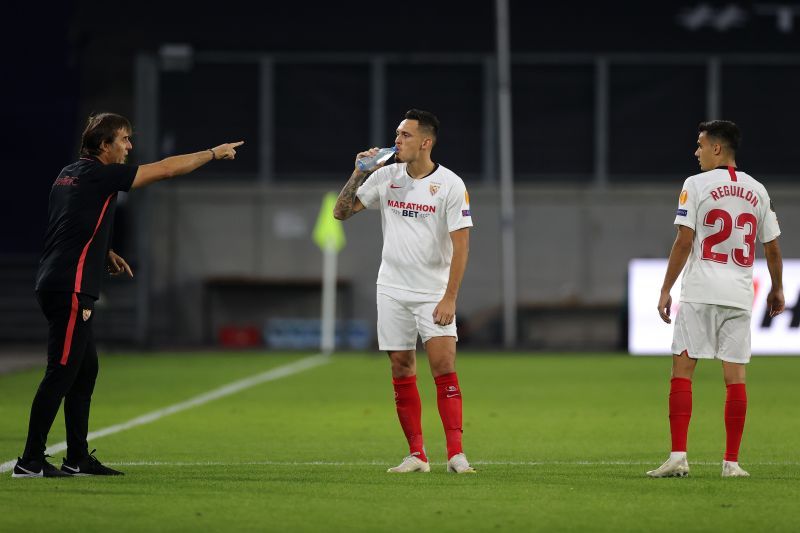
How Lopetegui is paving the way for a return of Sevilla's glory days
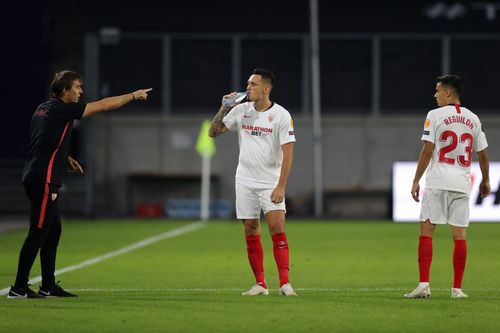
When Julen Lopetegui took over the reins of Sevilla Football Club from Pablo Machin in June 2019, they had just finished sixth in the La Liga and were knocked out from the UEFA Europa League in the Round of 16.
In the ensuing summer transfer window, Sevilla lost their key forwards - Wissam Ben Yedder and Luis Muriel. Midfielder Pablo Sarabia too was swayed away by Paris Saint-Germain in the same transfer window. Although the transfers slimmed down the squad, it allowed Lopetegui to go forward with complete personnel and tactical overhaul.
Cut to August 11, 2020. MSV-Arena, Germany. It is 87’ minutes on the stadium clock. Ever Banega gets the ball out wide and whips in a belter of a cross with his right. Lucas Ocampos twitches his neck muscles and glances at the ball.
The scoreline reads - Sevilla 1-0 Wolverhampton Wanderers.
Under Lopetegui, Sevilla finished fourth in the La Liga this season for the first time since 2017. In the semi-finals of the UEFA Europa League, they face Manchester United.
How have Sevilla and Lopetegui managed to turn around their fortunes?
Sevilla's 'Bermuda Triangle' at the back
Sevilla’s major improvement this season has been in the form of defensive solidity and stability. Just behind Real Madrid (25) and Atletico Madrid (27), Sevilla conceded the least goals (34) in La Liga this season.
Sevilla mostly starts games off with a more classical four-at-the-back system. But while defending, they switch to almost a five-at-the-back, with defensive midfielder (DM) Fernando sitting in the hole between the two centre-backs - Jules Kounde and Diego Carlos.
Signed from Bordeaux for €25 million, Kounde, a 21-year-old French international, has been a revelation for Sevilla this season. Partnered by Diego Carlos, the duo has bolstered Sevilla's defence, which is evident in the fact that the club has been unbeaten in all competitions since the restart.
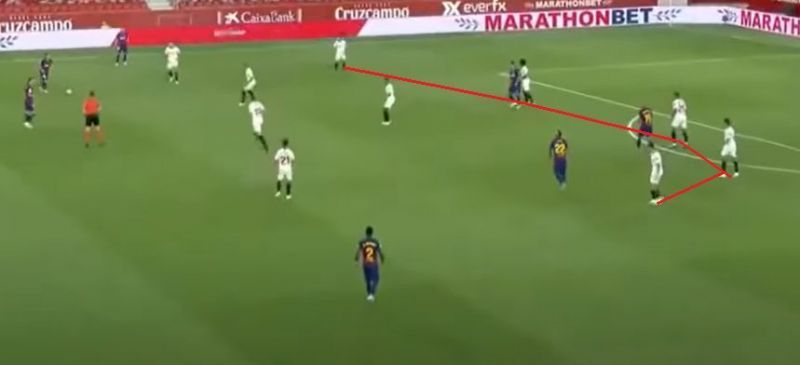
The Brazilian centre-back averaged one tackle per game and five clearances per 90 in the league, which is more than that of both Raphael Varane (0.9 tackles and 3.7 clearances) and Gerard Pique (0.9 tackles and 4.3 clearances). Both Kounde and Carlos are comfortable on the ball, having completing 85.9% and 84.2% of their passes respectively.
The third pillar of Sevilla’s defensive success is former Manchester City player Fernando. The 33-year-old defensive midfielder has been utilised by Lopetegui to liberate the two Sevilla full-backs and provide width to the attack.
Defensive duties are sacrosanct to Fernando as he regularly drops into the defensive line and registers two interceptions per 90, which is more than that of both Mikel Merino (1.4) and Casemiro (1.9). He also adds 0.4 blocks per 90 to aid any incoming counters.
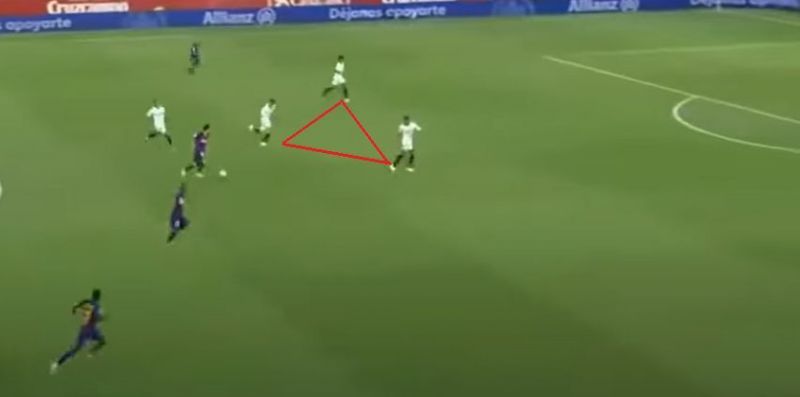
With Kounde and Carlos adept at covering grounds on counters and extremely quick on the turn, Sevilla have created a fortress at the back which was able to even nullify Lionel Messi and earn a 0-0 draw at home against Barcelona.
The fallacy of Sevilla's full-backs
As discussed earlier, the Sevilla full-backs push higher up the pitch, acting like wingers and adding width to the attack.
Sergio Reguilon, on loan from Real Madrid, and the club captain Jesus Navas have taken the left and right sides respectively. For Premier League fans, it might be unusual to see Jesus Navas play as a right-back, however, the position on paper is a fallacy.
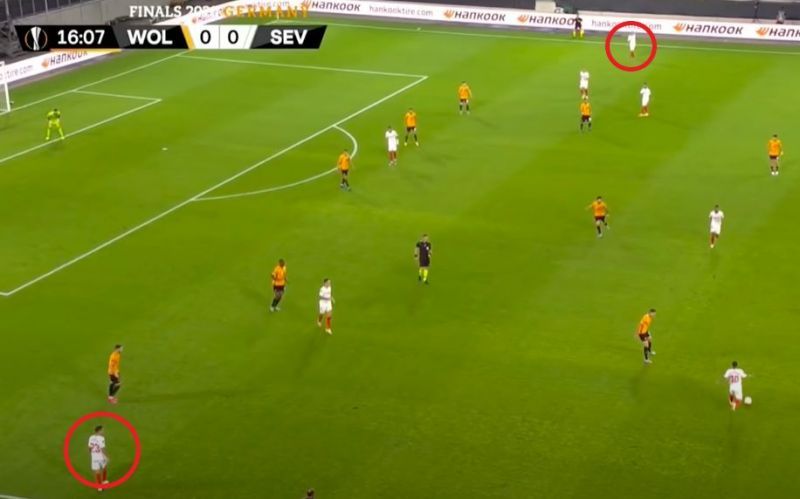
The natural wide players (LW and RW) in Sevilla's 4-3-3 formation tuck inside during the buildup and allow the full-backs to operate from the wide-forward position and stretch the field. The defending team, more often than not, loses their compactness at the centre while trying to mark all the attacking runs out wide.
When attacking, Ever Banega drops deep and dons the role of a wide deep-lying playmaker in-and-around the centre circle, belting in long diagonal balls to the two full-backs making runs up the field. When Banega is in control, Sevilla are in control.
Two cases to study in this regard are Sevilla's UEFA Europa League knockout matches against AS Roma and Wolverhampton Wanderers respectively.
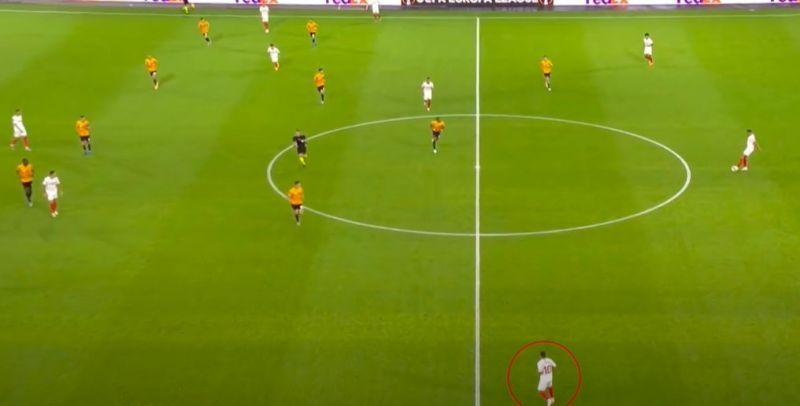
Reguilon and Jesus Navas have outperformed the Real Madrid full-backs in certain quarters. Navas, the 33-year-old Spaniard, recorded seven assists during the La Liga season, crowning the attacking duties Lopetegui entrusted him with.
Navas and Reguilon had 1.6 and 1.3 key passes per game respectively, which is more what Ferland Mendy and Daniel Carvajal managed for the 2019-20 La Liga champions.
The Sevilla full-backs stay wide and cross the ball to the forwards crowding inside the box or often get inside the box themselves. Reguilon took 0.9 shots per 90 and scored two goals in the league, clearly showing his intent to go for goal.
The duo hasn’t shied away from their defensive duties either. The 23-year-old Reguilon has been sensational in tracking back on the counter. The excellent transition from both the full-backs has allowed Sevilla to play with intent up the field.
The two Sevilla full-backs combined put in three clearances per game, which is more than what the duo at Real Madrid (2.1) managed during the season.
Reguilon also outperformed Mendy (0.9) with 1.1 interceptions per 90. Thus, it comes as no surprise that top clubs in Europe are flocking in for the young left-back’s signature.
The Oscillating Ocampos
When Sevilla signed Ocampos for €15 million from Olympique Marseille last summer, he was coming on the back of a 13-goal-contribution season and the plaudits of being a tenacious winger.
However, he was lacking in attacking output. Now, as he writes in the final few pages of his first season at Sevilla, Ocampos has already grabbed 17 goals and five assists in all competitions in 2019-20.
So, what changed for Ocampos?
What fundamentally aided Ocampos during the season was how Lopetegui deployed him in his 4-3-3 formation. The 26-year-old winger from Quilmes in Argentina is a gifted two-footed player, which allowed Lopetegui to play him in a free-role switching between the flanks.
In most La Liga matches, Ocampos operated from the right side of the pitch. His connection and understanding with Jesus Navas on the same flank bolstered Sevilla’s attacking threat.
With Navas pushing up the flanks, Ocampos oscillated between functioning as an inside forward by cutting inside on his left or as an out-and-out winger by drifting wide and creating space for Navas to cut in.
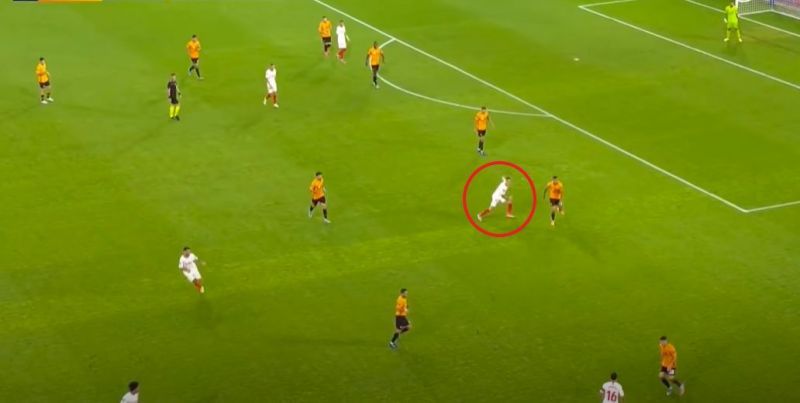
The 53-year-old former Spanish national team manager has been able to utilide Ocampos’ physical presence by pushing him to hover in and around the oppositions’ 18-yard box behind the centre-forwards.
After scoring five headed goals this season, it’s fair to say Ocampos can be a formidable aerial threat with his 6’1" frame. Case to study: Sevilla's UEFA Europa League Quarter-final match against Wolves.
Operating as a wide forward, the Argentine took 2.5 shots per game in the 2019-20 La Liga, which is higher than what Erling Braut Haaland managed in the Bundesliga this season while playing as a centre-forward.
However, Ocampos’ bag of expertise isn’t only limited to his brilliance in the attacking half. His undying work rate has made Sevilla hold their shape against counters with their full-backs high up the pitch. His 1.6 tackles per 90, crowning his defensive output, stabilised Sevilla.
Julen Lopetegui’s shot at redemption
In 2018, the Spanish Football Federation (RFEF) felt betrayed by Julen Lopetegui when the news of him joining Real Madrid was announced during the buildup to the FIFA World Cup.
Even though Lopetegui was unbeaten during his 20-game tenure with La Furia Roja senior team, he was sacked from the managerial position with immediate effect. In four months' time, after a string of unfavourable results, he was left without a club when Real Madrid terminated his contract on October 29.
If Lopetegui and Sevilla can edge past Manchester United and book a ticket to the UEFA Europa League finals come Sunday, Lopetegui would have had his redemption to some extent.
* Stats taken from whoscored.com